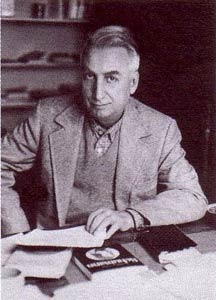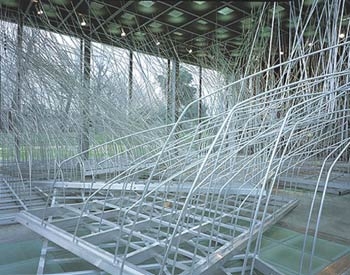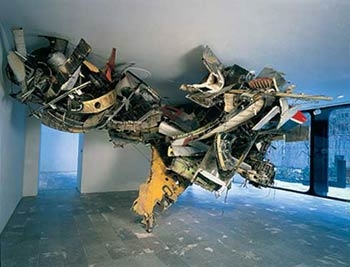Feature: Reviews
Theory in a Box: a review of two shows
- Centre Pompidou and Fondation Cartier pour l'art contemporain
- November 27, 2002 – March 10, 2003 and November 29 2002 – March 30, 2003
Roland Barthes
Centre Pompidou, November 27, 2002 – March 10, 2003
Ce qui arrive, une exposition conçue par Paul Virilio
Fondation Cartier pour l’art contemporain, November 29 2002 – March 30, 2003
Two exhibitions appear in the same cultural hub at the same time guided by the same curatorial ethos. One focuses on the life and work of the French linguist and philosopher Roland Barthes and the other, organized by the French architect and philosopher Paul Virilio, coalesces the work of different artists in order to question the relationship between technology and accident. Both appear in Paris, France at major cultural institutions ‚Äì the Centre Pompidou and the Fondation Cartier pour l’art contemporain. Both are manifestations of deliberation and organizational effort having been devoted to the irrevocably immaterial object of theory ‚Äì ideas and the text. Two shows appropriating the display box of the gallery as a means to execute the well-nigh impossible: to make material immaterial, to bring the experience of the book to tangible life ‚Äì reading, solitary thinking, individual intellectual fancy and, last but certainly not least, the act of critical interrogation. Mere coincidence, or a sign of the times?
Without sounding like a hopelessly retardataire Hegelian, I opt for the latter. I use the term "times" as it might refer to an aggregate of technological forces behind and constitutive of culture – Zeitgeist as a result of the machine, what it always was anyway. As a ledger of today, these shows signify exhaustion, the fatigue and transformation of theory on the one hand and the geriatric dotage of post-object conceptualism on the other. This is not to say that either one of them, theory or immaterial conceptualism, is finished. We are by no means witnesses to yet another shift necessitating that browbeaten and browbeating prefix, "post." (Can we truly withstand another such shift?) Rather, the appearance of these two shows (not to mention their many problems) marks the significant changes that both theory and non-object conceptualism have endured and must endure. What then might we see on the horizon after these shows? Theory as journalism? Beauty, form and the art object reconceived? But a review of the shows begs before dialectics can contend.
Tucked away on the top floor of the Centre Pompidou, Roland Barthes is an homage to a cultural hero – a French exhibition with texts, videos and audio only in French for the French people. This linguistic one-sidedness is truly unfortunate, especially for a show devoted to a linguist who so radically transformed studies in the humanities at Anglo-Saxon universities. This limitation also mars the otherwise wonderfully successful public and culturally cosmopolitan space of the Centre Pompidou. Beyond being merely the language of communication for Anglo-Saxons and their colonial inheritors, today English is the language by which the world is able to communicate. Yet this contradiction is one among many. Another, one that perhaps undermines the show at its very core, is the role of the “thing.”
The primary thrust of Roland Barthes is to bring home the manner in which Barthes inaugurated the "reading" of consumable objects, what in North American universities gave rise to the commonly held practice of reading the landscape and its many objects as though they were a text, a practice that would bring forth the field of Cultural Studies. The show consists of eleven separate spaces, "un réseau…organisé en onze étapes" according to the show’s pamphlet, focusing on Barthes’ structuralist reading-cum-deconstruction of objects. This organization of space creates a gallery dynamic fluctuating between a planned heuristics of what one should know about cultural heroes and those unforeseen experiences of art for art’s sake. What fills the space of these eleven "steps" varies, from pedagogic video installations attempting to explain the ideas and work of Barthes, such as his idea of "mythology," to conceptualist installations, such as La Pneumathèque by Anne-Marie Jugnet and Alain Clairet in which a series of slide projectors are lined up, each projecting a word onto an adjacent wall.
Entering the show, one walks into a large darkly lit space busy with the hum of mechanical white noise, where ten or so video monitors are each devoted to one of Barthes’ famous myths; and the projection onto two transparent screens of a play by Bertold Brecht (an exception to the all-French rule, as this film was in German with French subtitles) and a movie by Alain Robbe-Grillet. With the busyness of this technological melange one might miss what lines the walls upon entering: several long rectangular glass boxes enclosing Barthes’ original writing and first-run manuscripts of Le Degré zéro de l’écriture from 1947 and 1953.
Far noisier than the rattling in the background of various videos resounds the exhibition’s most egregious contradiction. While the intention on the part of curators might have been (giving them the benefit of the doubt) to show the intellectual processes of a very original thinker, the result of hermetically sealing Barthes’ writing in a transparent box is instead a two-part fetishization – that of the "original" and the "author" – that completely goes against the teachings of Barthes, in particular as they are reflected in his pivotal essay "Death of the Author" (1968). It would seem that, through its manifold cultural references, the exhibition attempts to do justice to this very important essay, in particular the notion that the "author" is but a construction of society and political economy. However, these cultural references are often only made as they shore up the author’s brilliance, the way in which culture emerged from or centered upon Barthes’ life as a thinker. The show’s messages of hero worship and authenticity, whether witting or unwitting, are nevertheless most effectively brought home by the placement in vitrines of original texts, those written by Barthes as well as the Utopian Socialist Charles Fourier in another area of the exhibition devoted to Barthes’ book on three "logothètes," or founders of language, Sade, Fourier, Loyola (1971).
In a glint of hopeful rumination, I would like to think that the motivation of all of this displaying of originals was somehow functional. As with the truly inspiring covering of a large wall with Barthes’ note cards towards the close of the show (perhaps its only successful moment) these originals were meant to provide would-be writers with a model for working. Regardless of the intention (if this were in fact the intention) the result is the reactionary fetishization of archives, what Jacques Derrida famously called “archive fever,” and, more importantly, the heroic and metaphorical embalming of the author, especially his originality and original writings.
If the primary problem of the show devoted to Roland Barthes is one of fetishizing originals and originality, the overwhelming drawback of Paul Virilio’s Ce qui arrive is the dumbing fetishization of the copy. Yet the overwhelming primacy of the spectacle at work in Virilio’s show is, fortunately, not the first thing one experiences upon entering. The show starts on the ground level of the Fondation Cartier, at the street, and continues below ground, on the lower level. At street level where one begins there are two works, an installation by the architect Lebbeus Woods with sound by Stephen Vitiello and a sculpture by Nancy Rubins. Both sides, two glass rooms visible to passersby on the street, are devoted to works manifesting the "moment of the fall" [l’instant de la chute]. It is here, openly and clearly visible to the public, where the most interesting works of the show are on display, save one additional piece, a bizarre video below ground made by Aernout Milk.
Woods is an architect who investigates landscapes of disaster, erasure and clean-up. In this piece he captures the condition of suspension – the in-between moments of falling, that is, the moments after jumping from a stable precipice and before hitting the ground. In doing so he foreshadows what follows downstairs, namely the video image of that hopeless pair of individuals who, while hugging, jumped from the windows of the Trade Towers on September 11, 2001, video sequences which have become perhaps the most traumatizing memories of the event for many.
Accompanying Woods’ suspended labyrinthine network of nine-hundred aluminum tubes is Vitiello’s sound installation designed in collaboration with Woods. In a synaesthetic intervention, Vitiello captures photocells of light passing through the glass of the gallery walls and the shadows cast by visitors and translates them into sound. In addition, he has placed a microphone outside the Fondation that captures particularly loud events of the street, such as groups of people or large trucks passing by, and channels the noise back into the space surrounding Woods’ piece. In terms of pure form, the work by Woods and Vitiello makes for a singular experience, one that is ambient in terms of immediacy and reference. However, when one has witnessed the entire show, especially those images of catastrophe on exhibition below, the content of the pieces are eerie abstractions of the spectacle, merely the rationalization of what is dumbly accessible in iconic visual form downstairs.
Opposite the work by Woods and Vitiello is Rubins’ large sculpture, a motley-colored hunk of soldered piebald detritus from what would appear to be airplane wreckage, suspended precariously in midair. Rubins’ work, not unlike that of Woods and Vitiello, creates a provocative beauty from the chaos and tragedy of technological calamity.
Located downstairs are a series of videos, a combination of news tracks taken from the mass media and pieces by artists from around the world, the subject of which is technological and natural disaster. The first four are remarkably (or perhaps not) images of September 11. One of these, Nine-Eleven, is by the video artist Tony Oursler, an artist known mostly for his delightfully humorous projections of wincing and grimacing faces onto life-size dolls and other stuffed creatures. Instead of his usual work, however, Virilio has collected from Oursler a video he made by chance on September 11 as he, like many other artists, lives in New York. Hence, Oursler’s piece is not really “art” per se, but a documentary, or worse yet, haphazard home video. With this work, Oursler the clever artist becomes Oursler the emotional subject – the victim.
What follows in the subterranean gallery is a discursive and nonchalant array of videos, all of which portray disaster of some type: explosions, both intentional and otherwise, earthquakes, volcano eruptions, floods, and news coverage of terrorist attacks from around the world. The videos range from willfully produced and directed documentary, to news clips, to actual video art pieces.
|
There is one video work by the Dutch artist Aernout Milk* that is the exception to what is otherwise a maelstrom of mediocrity [image 4]. Milk’s unhomely mise-en-scène of a stock trading room after a market crash is far more subtle than most everything that surrounds it. This is because the video is not just about the one-to-one relationship video technology has with seeing, that, most reductively, it is a mechanism of verisimilitude (in the simplest sense, documentary photography’s grandchild), but rather video as a medium also concerned with Baroque theatrics, the layering and construction of the real, and seeing as setup. And, as such, one must carefully watch in this video for the bizarre doubling of people, real persons adjacent to their mechanical double - a subtlety that was missed by whomever wrote the exhibition pamphlet.
If I understand correctly - or more honestly, if I tweak the experience of the show in just the right direction ’ Virilio’s message concerns the dialectical relationship between violence and progress. With any so-called technological progress there inevitably come violence and destruction as well. Yet, I must admit that I am being very generous in positing this, as viewing the images and installations of this show in their entirety, there is truly no cohesive message. The only consistency of this show is one of (to use a highly idiomatic phrase) rubber-necking. Virilio has amassed a group of imagery that, from screen to screen, in one visual after another titillates the desire to see disaster, not to experience it viscerally with the body, but to visually experience it with the eyes: to witness it within the safety of the home, a movie theater, or even within the cozy comfort of a museum or gallery space.
The not-so-coy flirtation with disaster in this show is one more chapter in Virilio’s on-going personal love-hate saga of technology, modernization and the decimation of authentic living made more interestingly available in his provocative writings. The problem with this show, not unlike the Barthes show, is that it flattens and deflates theoretical inquiry and, more importantly, the critical deliberation that comes with reading a text. Ironically, all of the noisy video, the visual bells and whistles of Ce qui arrive, domesticates the act of reading what are otherwise (in the case of Virilio’s writing) texts with often unpredictable repercussions.
I would say, in both cases, with Roland Barthes and Ce qui arrive, one is destined to have a better experience - that is, learn more and have greater aesthetic pleasure - in staying home and reading the book. Read anything and everything by Roland Barthes. Read the catalogue for Virilio’s show.
Following Clement Greenberg, maybe it is time once again to bring back the Laocöon. Towards an even newer Laocöon we go: let text be text and things be things and the gallery be for things and not texts. With that said, what exactly might be a "thing"?
*The Fondation Cartier has spelled this artist’s name in at least three different ways. In addition to that appearing in the show pamphlet, Aernout Milk, at the site his name is spelled also Aemout Mik and Aernout Mik.




